How To Conduct An Effective Social Media Audit: Steps, Tools, And Insights
Conduct a thorough social media audit to assess your performance. Uncover opportunities for growth and refine your approach for maximum impact.


You know something's off with your social media performance, but you can't quite pinpoint what it is. Engagement is inconsistent. Competitors seem to be doing better. You're posting regularly but questioning if it's actually driving results. Sound familiar?
These symptoms all point to the same diagnosis: you need a social media audit to understand what's happening and get clues on how to fix things.
But where do you start? What metrics actually matter? How do you turn overwhelming data into actionable insights?
In this guide, I'll break down exactly how to conduct a social media analysis that reveals what's working, what's wasting your time, and what opportunities you're missing. I'll walk you through specific steps, real examples, and the tools that transform hours of manual work into strategic insights you can implement immediately.
Key takeaways
-
Analyze branding consistency: Ensure all your profiles look and feel the same so your audience can instantly recognize your brand across platforms.
-
Run a content analysis: Identify what type of content performs best and double down on the formats and pillars that drive the most engagement.
-
Check your audience demographics data: Align your content strategy with the demographics of your actual audience to make sure you’re reaching the right people.
-
Dive into your performance data:Regularly measure KPIs against objectives to spot growth trends and understand whether your strategy is working.
-
Run a multiple-layers data analysis:Go beyond surface-level metrics by using sentiment analysis and AI insights to uncover deeper patterns and forecast performance.
-
Provide context for the insights by adding competitor’s results: Benchmarking against competitors helps you put your performance into perspective and uncover gaps or opportunities in your strategy.
What is a social media audit, and what are the benefits of performing one?
A social media audit is a comprehensive review of your brand’s social media presence, performance, and strategy. It helps you understand what’s working, what’s not, and where you can optimize to achieve better results.
Think of it as a health check for your social media channels—analyzing everything from branding consistency, content formats, audience engagement, and performance metrics to how you stack up against competitors.
Why run a social media audit?
- Clarity on your current performance – Get a clear picture of how your brand performs across all platforms.
- Better content strategy – Identify your top-performing formats, content pillars, and trends to replicate success.
- Audience alignment – Ensure your content reaches the right audience and speaks to their interests.
- Optimized ROI – Understand whether your organic and paid efforts are delivering measurable value.
- Competitive edge – Learn how you perform compared to industry benchmarks and competitors.
- Stronger brand consistency – Spot discrepancies in branding, bios, or messaging that may affect trust.
Regular audits (quarterly or bi-annually) ensure you’re not just posting for the sake of it but making data-driven decisions that improve brand visibility and engagement.
What are the main types of social media audits you should run?
Not all social media audits are the same. Depending on your goals, you’ll want to focus on different layers of analysis. The three most valuable types are:
Content audit
A content audit helps you review what you post and how it performs. It answers questions like:
- Which formats (videos, carousels, stories, etc.) resonate best with your audience?
- What content pillars generate the highest engagement?
- Do your posts align with your brand’s tone of voice and business objectives?
By running a content audit, you can refine your content mix, double down on what works, and phase out formats or topics that don’t deliver.
Performance audit
This type of audit focuses on KPIs and growth trends across platforms. The goal is to compare your performance against objectives and uncover opportunities for optimization.
A performance audit typically looks at:
- Follower growth and audience reach
- Engagement rate (likes, comments, shares, saves)
- Organic vs. paid performance
- Content distribution efficiency across platforms
With historical data, you can spot long-term trends and identify whether your strategy is improving or stagnating.
Competitor’s KPIs audit
A competitor audit helps you understand where you stand in your industry. By benchmarking your performance against competitors, you gain context for your numbers and strategic direction.
Things to look at include:
- General performance metrics (reach, engagement, followers)
- Content pillars competitors focus on
- Posting frequency and format mix
- Engagement drivers (what type of posts spark conversations in their community)
This type of audit doesn’t just show you what others are doing—it highlights opportunities to differentiate your brand and fill content gaps in the market.
How to run an effective social media audit?
Running a social media audit might feel like one of those tasks you keep pushing to next quarter, but, speaking from experience, you're leaving valuable insights on the table.
A well-executed social media audit reveals exactly what's working, what's wasting your time, and where your next big opportunity lies.
Let’s review the steps you should take so that the process doesn’t feel overwhelming (and you stop postponing it).
Analyze branding consistency
Before you start analyzing performance metrics, take a step back and look at the basics. Your brand consistency across platforms directly impacts how easily people recognize and remember you.
- Do all your accounts have the same profile image? This may sound like just aesthetics, but it's actually about instant brand recognition when someone sees your content in their feed. Make sure all accounts use the same profile image, whether it’s the logo, a campaign image, or something else.
- Is your website mentioned in the contact information of every account you have? You'd be surprised how many brands miss this simple conversion opportunity.
- Are your bio and description optimized for SEO? Platforms like TikTok and Instagram increasingly function as search engines. Your bio needs to work harder than just stating what you do.
Run a content analysis
Your content is the engine of your social media presence. Understanding what resonates with your audience transforms posting from guesswork into social media strategy.
Identify what your best-performing content formats are
Different content formats serve different purposes and generate varying levels of engagement. Videos might drive awareness, while carousels encourage deeper interaction. Understanding these patterns helps you match format to objective.
When you analyze your post types by engagement, like in the example I've inserted below, you might discover that carousels significantly outperform single images, or that Reels generate solid engagement despite requiring more production effort.
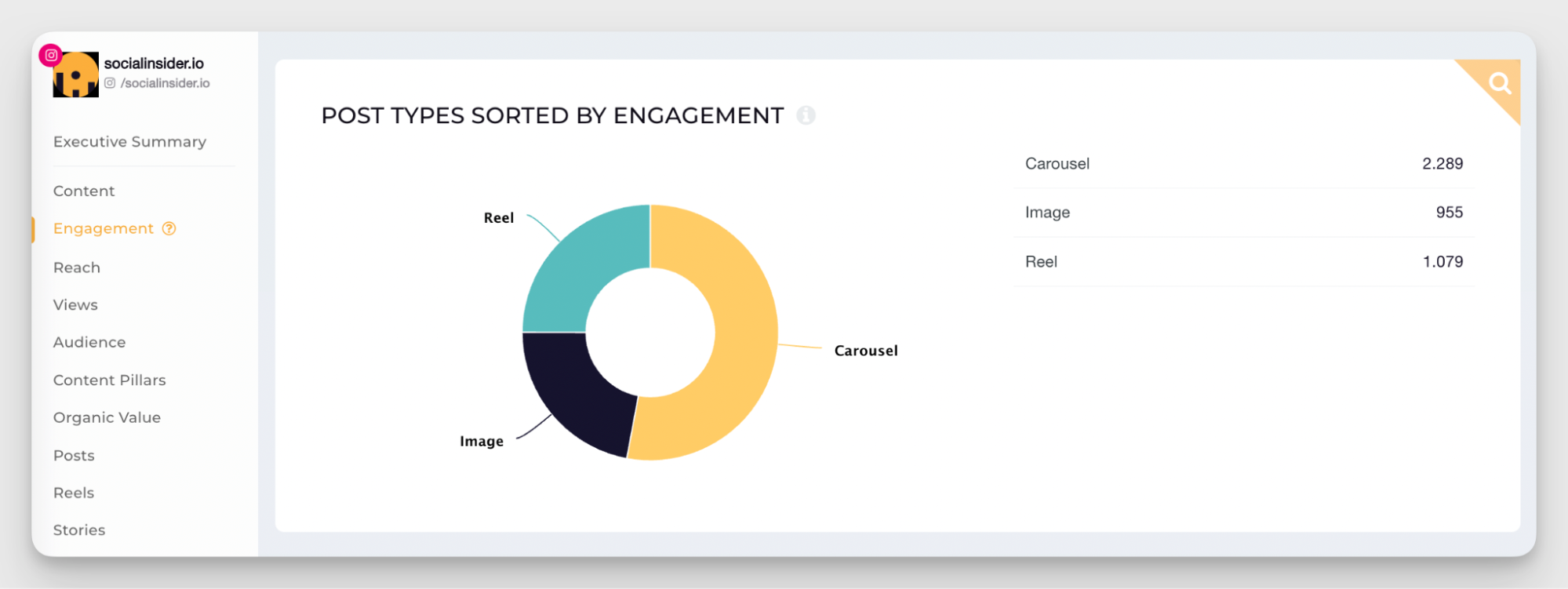
This kind of social media content analysis transforms your content strategy from hoping something works to knowing what works.
Discover your most engaging content pillars
Content pillars are the thematic categories that organize your posting strategy. Tracking their individual performance reveals which topics your audience actually cares about versus what you think they should care about.
I'll show you below two ways in which you can analyze content pillars with Socialinsider:
- Option 1: Analyze industry-specific content pillars that are AI-based. The platform uses AI to automatically categorize your social media content into industry-standard pillars, revealing patterns you might not notice manually. You might discover that industry news generates significantly more engagement than product updates, or that educational content outperforms promotional posts by a wide margin. This intelligence guides your content decisions.
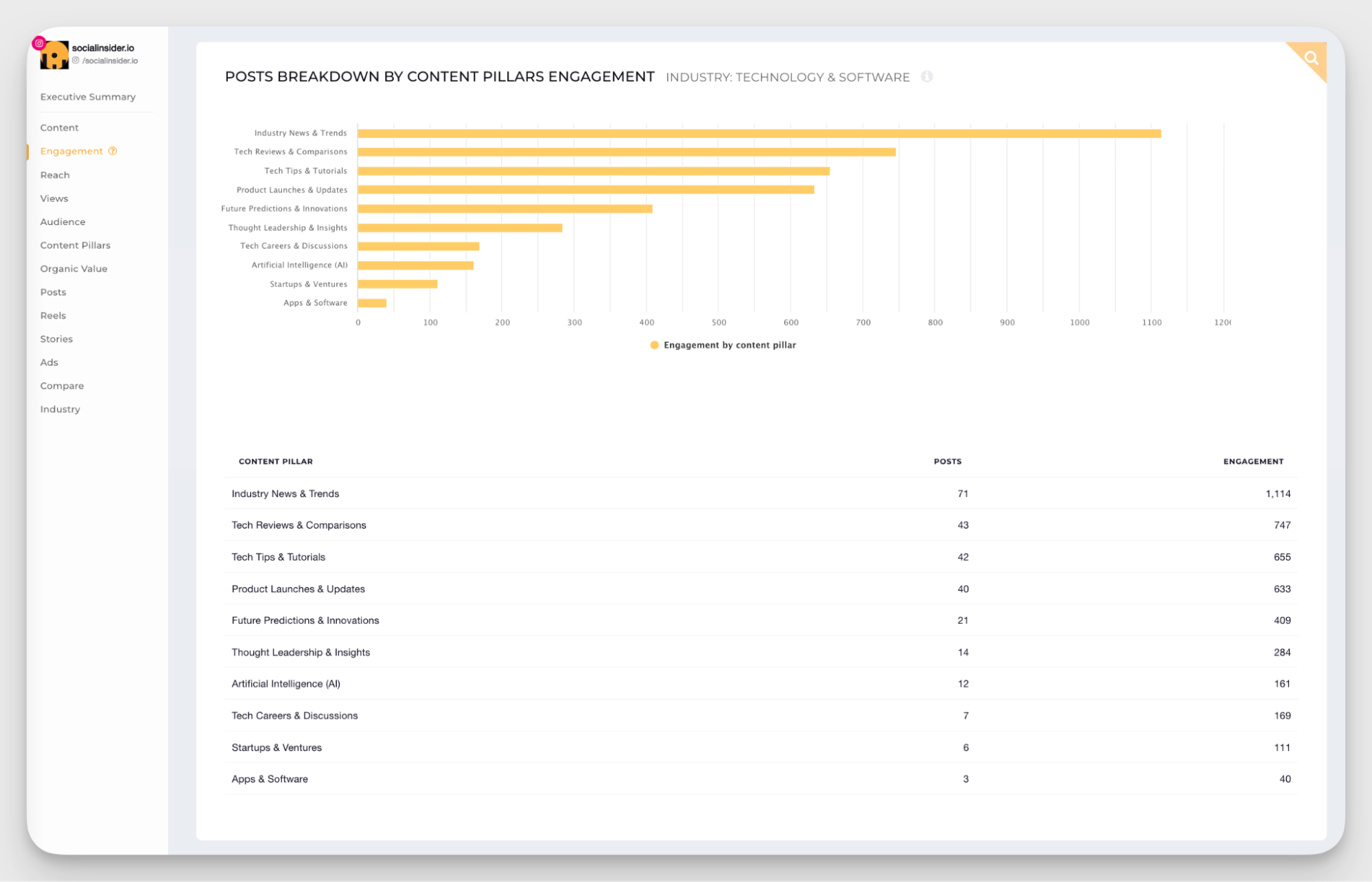
- Option 2: Create your own brand content pillars. Standard categories don't always capture your unique content strategy. Maybe you're testing user-generated content against professionally produced material, or tracking the performance of different campaign themes. In this case I recommend trying the custom content pillars, which let you measure what matters most to your specific strategy.
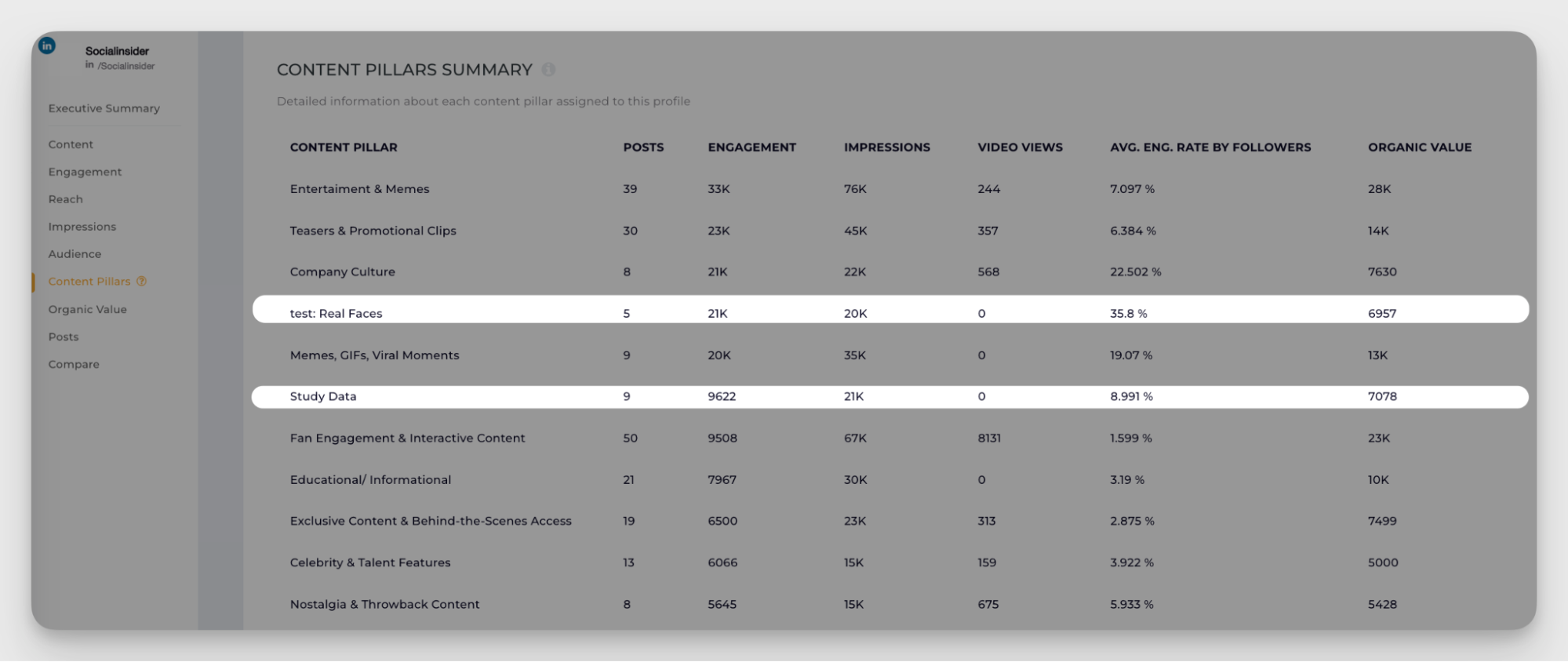
During an interview I had with, Alex Khan Social media strategist & CEO of Attractive Media explains how this works in practice, he explained:
We try to track recurring elements. We apply strategies such as dedicated hashtags, which can then be automatically analyzed. We add a hashtag to these content pillars, and then we can analyze which gives us the most reach and which gives us the most engagement.
Understand what your top-performing posts have in common
Pattern recognition is where social media audits become truly valuable. Your top posts likely share common elements, such as specific topics, formats, posting times, or emotional triggers.
In Socialinsider's posts section, you can search for specific campaigns or content types and apply custom tags, as shown in the image below. This tagging system lets you group posts by various criteria, such as campaign names or content themes.
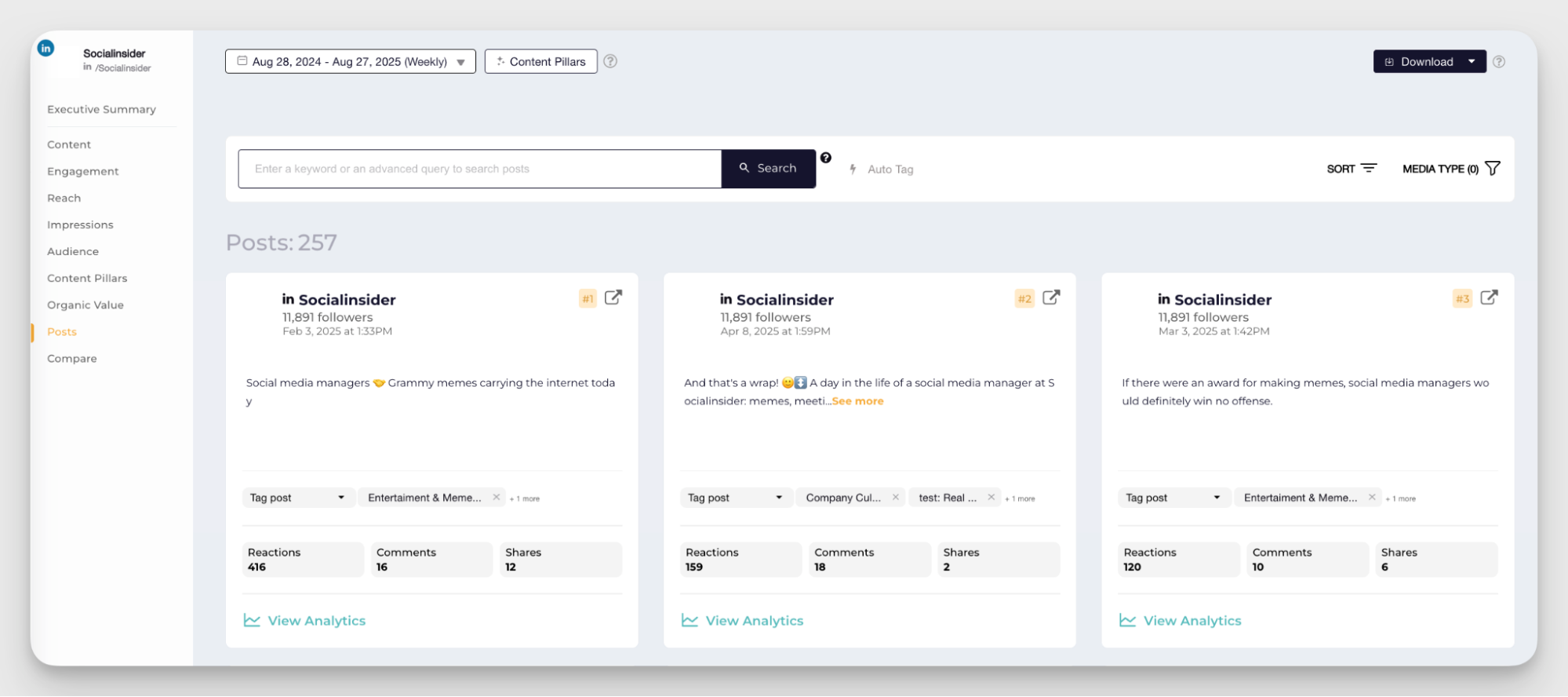
Once tagged, you can filter and analyze these groups to identify what consistently drives performance.
Check your audience demographics data
Creating brilliant content for the wrong audience is like hosting a heavy metal concert at a jazz festival (spoiler: it will be surprising, but mostly loud and ineffective). Your social media audience analysis ensures alignment between who you're trying to reach and who's actually listening.
Geographic distribution tells you whether your content timing and language choices match your actual audience. If your content targets North American professionals but your follower base is primarily in Europe, you're posting when they're asleep and using cultural references they might not understand.
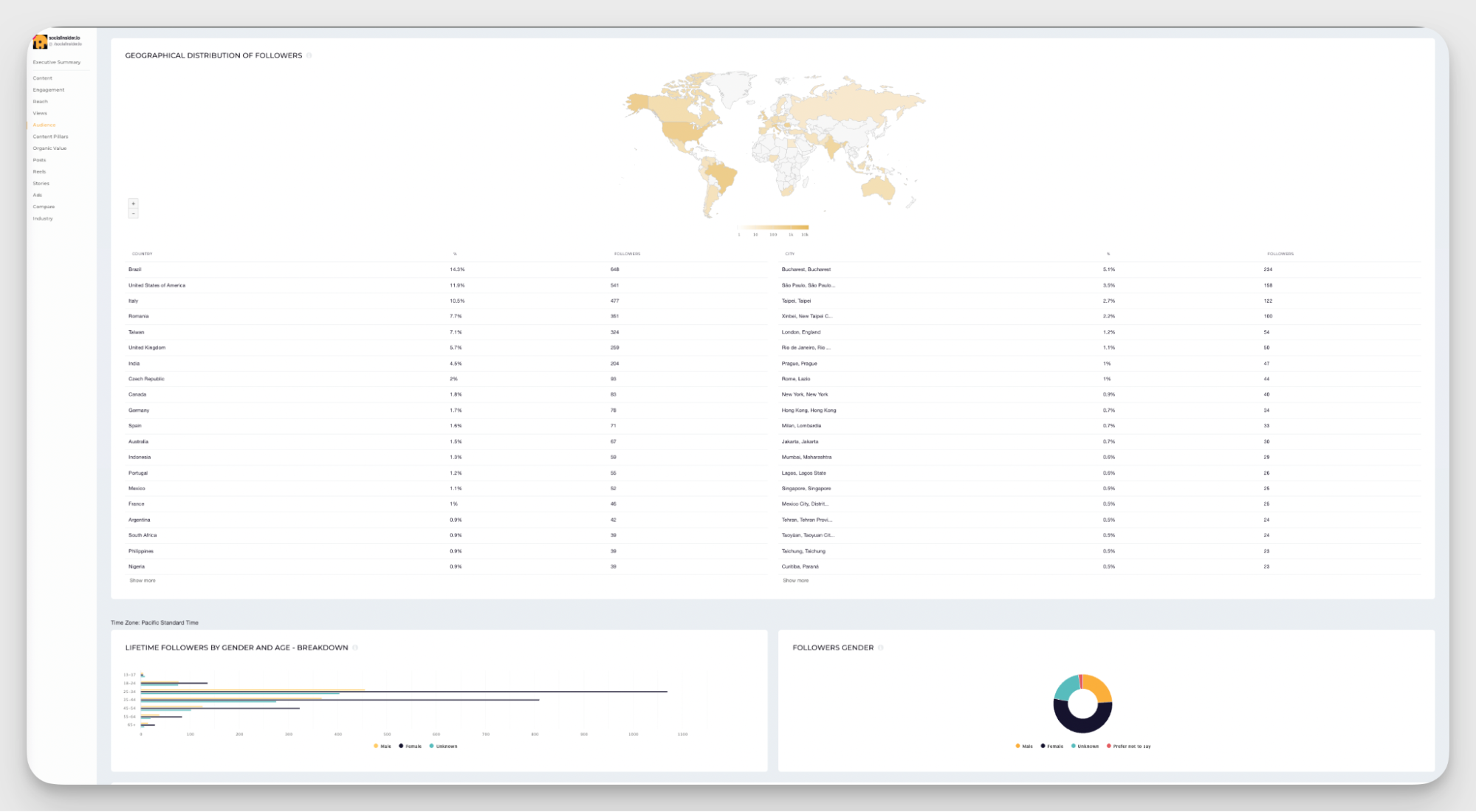
My tip? Use this type of data that you can find in the Socialinsider dashboard to inform decisions and adjust social media tactics, including posting schedules, language localization, and determining which platforms warrant more investment.
Dive into your performance data
Numbers tell stories, but only if you know which ones to look at and how to interpret them. I'll leave you down below the metrics that actually matter for your audit.
Compare KPIs against objectives
Follower growth is about accumulation, but also about speed and sustainability. My advice is to look at growth patterns to understand what is happening.
Consistent growth suggests your content regularly attracts new audiences, while dramatic spikes (followed by similarly dramatic lows) often correlate with specific campaigns or viral moments. While you should analyze and potentially replicate campaigns that produce spikes, you should also aim to have consistent organic growth even in periods when you’re not running specific campaigns.
The analytics dashboard below shows how tracking both total followers and growth percentage over time reveals these patterns. A sudden growth acceleration tells you something worked, and your job is figuring out what and why.
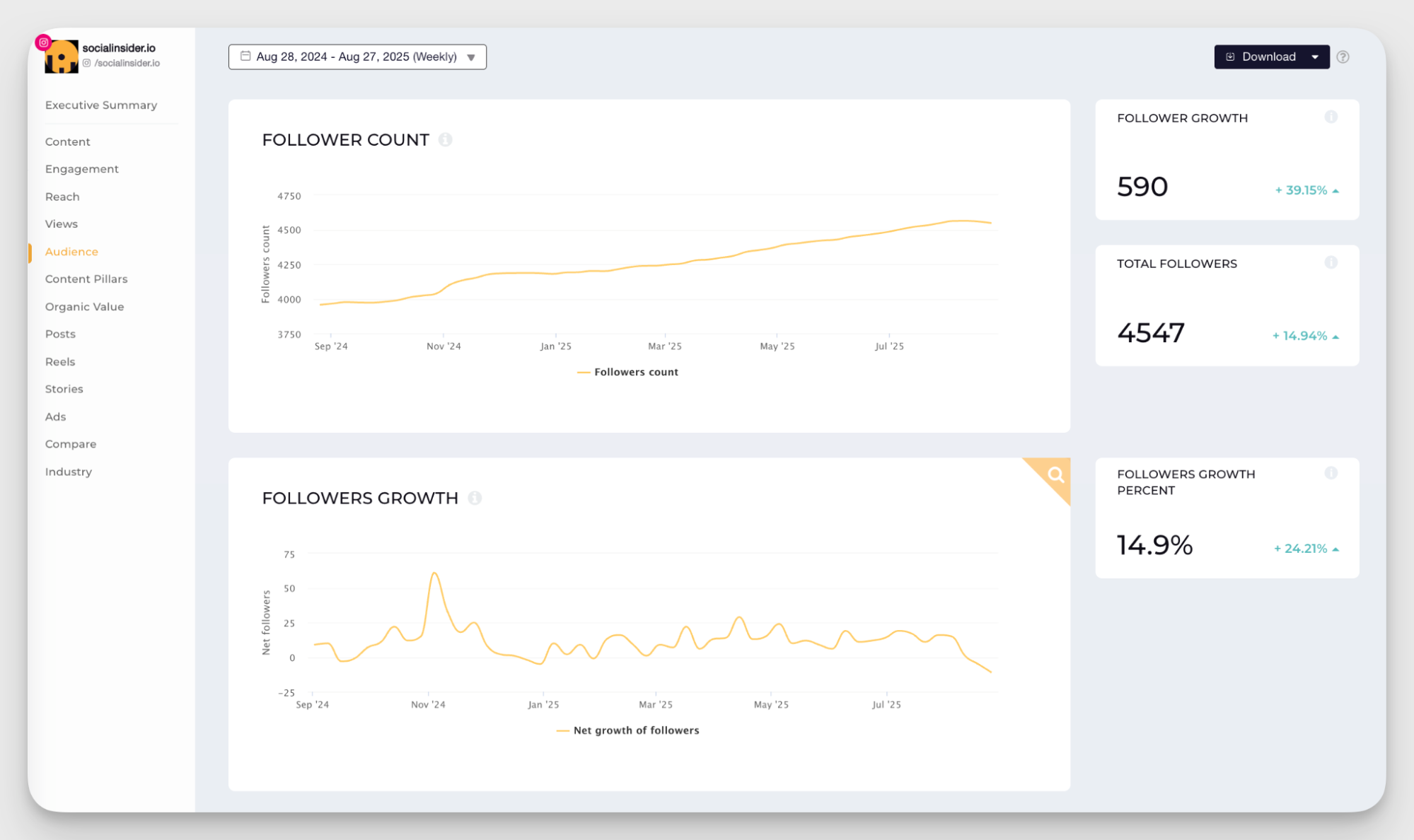
Engagement numbers mean little without context. An engagement rate tells you what percentage of your social media audience actually interacts with your content. Note: a small, engaged audience often delivers more value than a large, passive one.
When analyzing your social media engagement distribution, look for patterns in how different engagement types trend over time. Rising click rates suggest your CTAs are improving, while declining engagement rates despite follower growth might indicate you're attracting the wrong audience.
Here's what Alex Khan told me about his audit approach:
We primarily focus on impressions and engagement, filtering them in real time by content pillars, formats, and platforms. And we try to track recurring elements. This gives us the opportunity to continuously refine and iterate the overall strategy.

Based on experience, to identify real trends rather than anomalies, you'll need extended historical data of at least three months, preferably six or more.
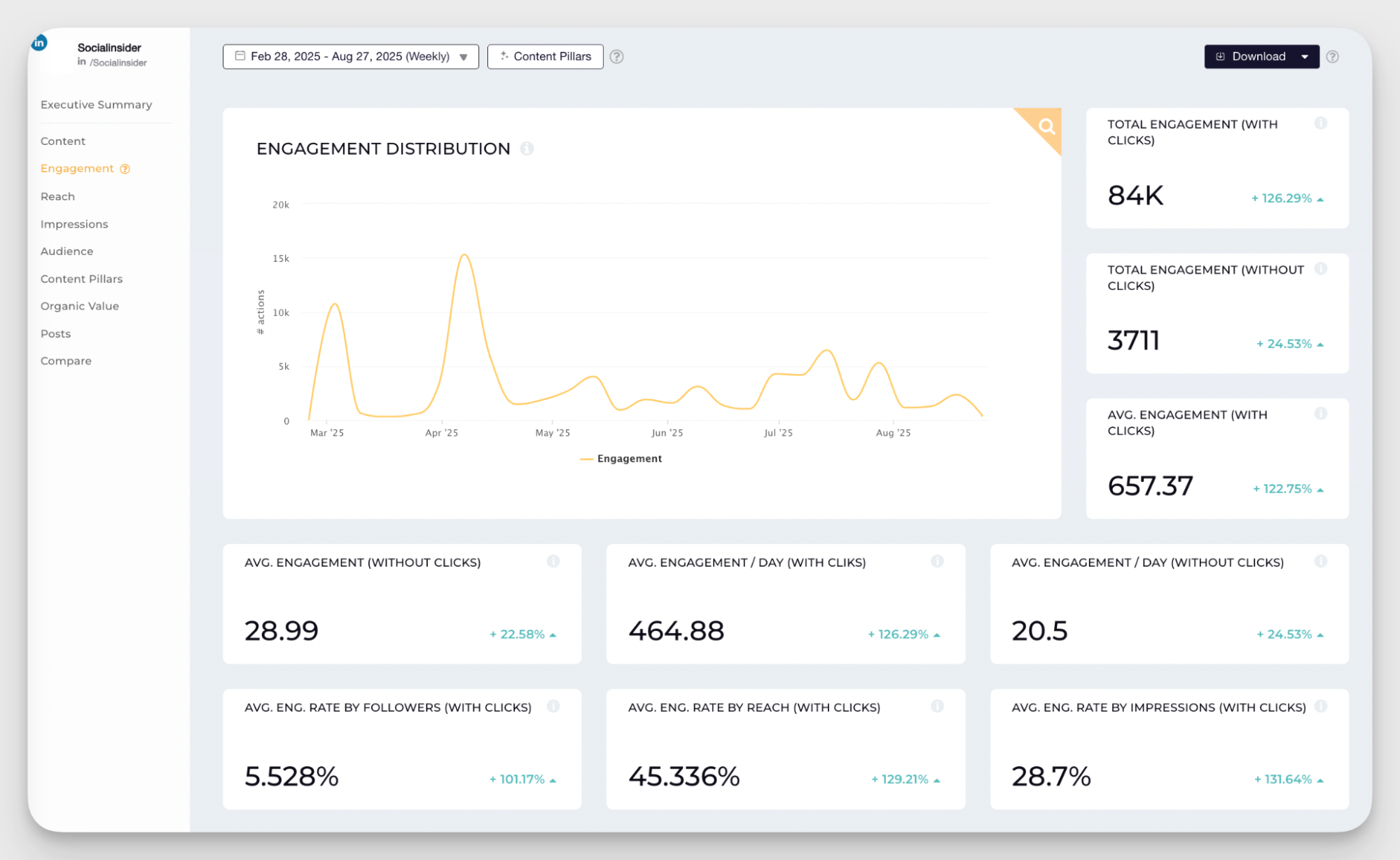
Comments indicate conversation and community building, while shares represent the ultimate endorsement — someone staking their reputation on your content. These metrics reveal content that captures attention and sparks action.
My advice is to track how these metrics fluctuate over time. A spike in comments might indicate you've hit on a controversial or highly relatable topic. Steady share rates suggest you're consistently creating value worth passing along. Both metrics together paint a picture of content that engages and spreads.
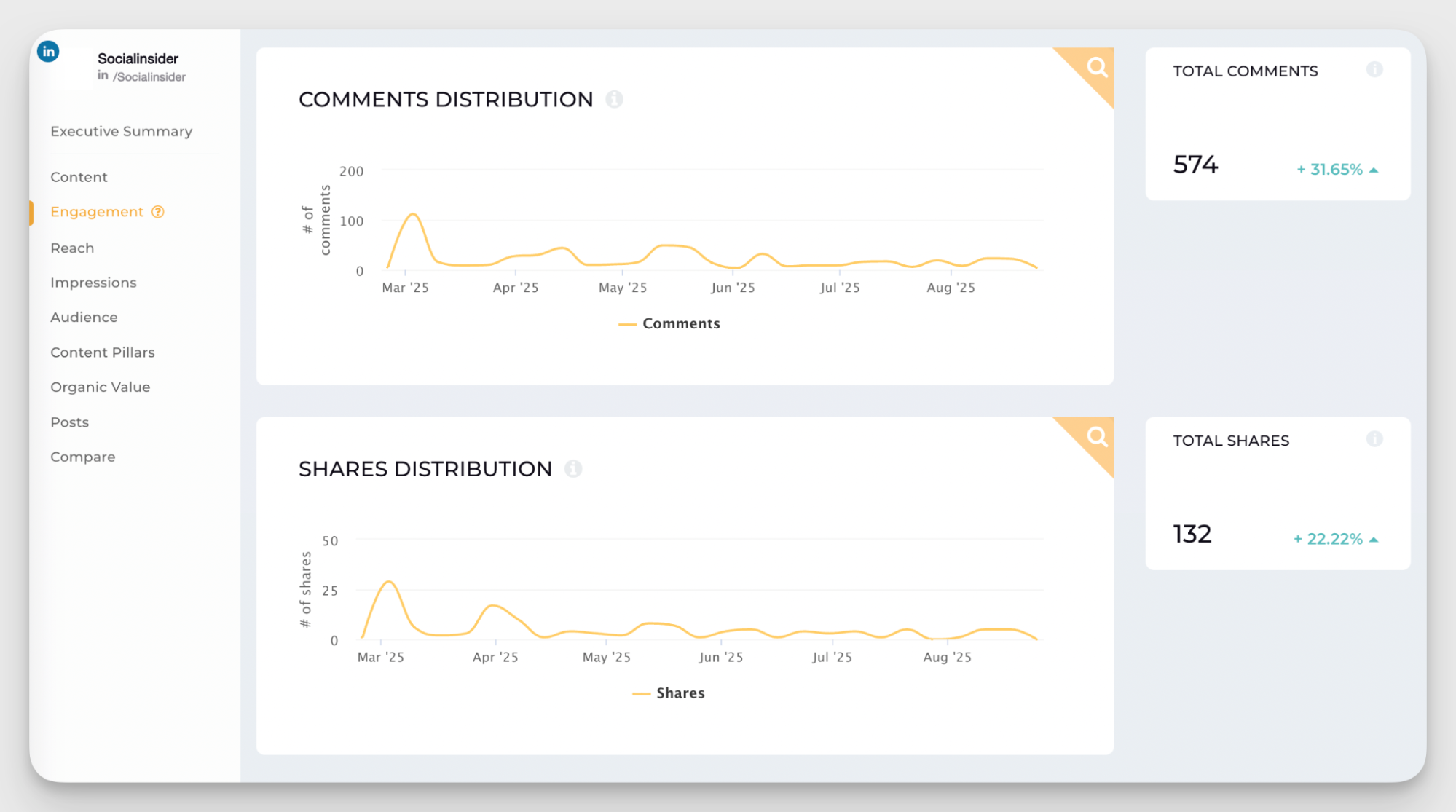
Reach tells you about potential audience size, while views indicate actual content consumption. The relationship between these metrics tells you how effectively your content captures and holds attention.
When your reach rate exceeds your follower count significantly, it means that your content is breaking out of your immediate circle through shares and organic amplification.
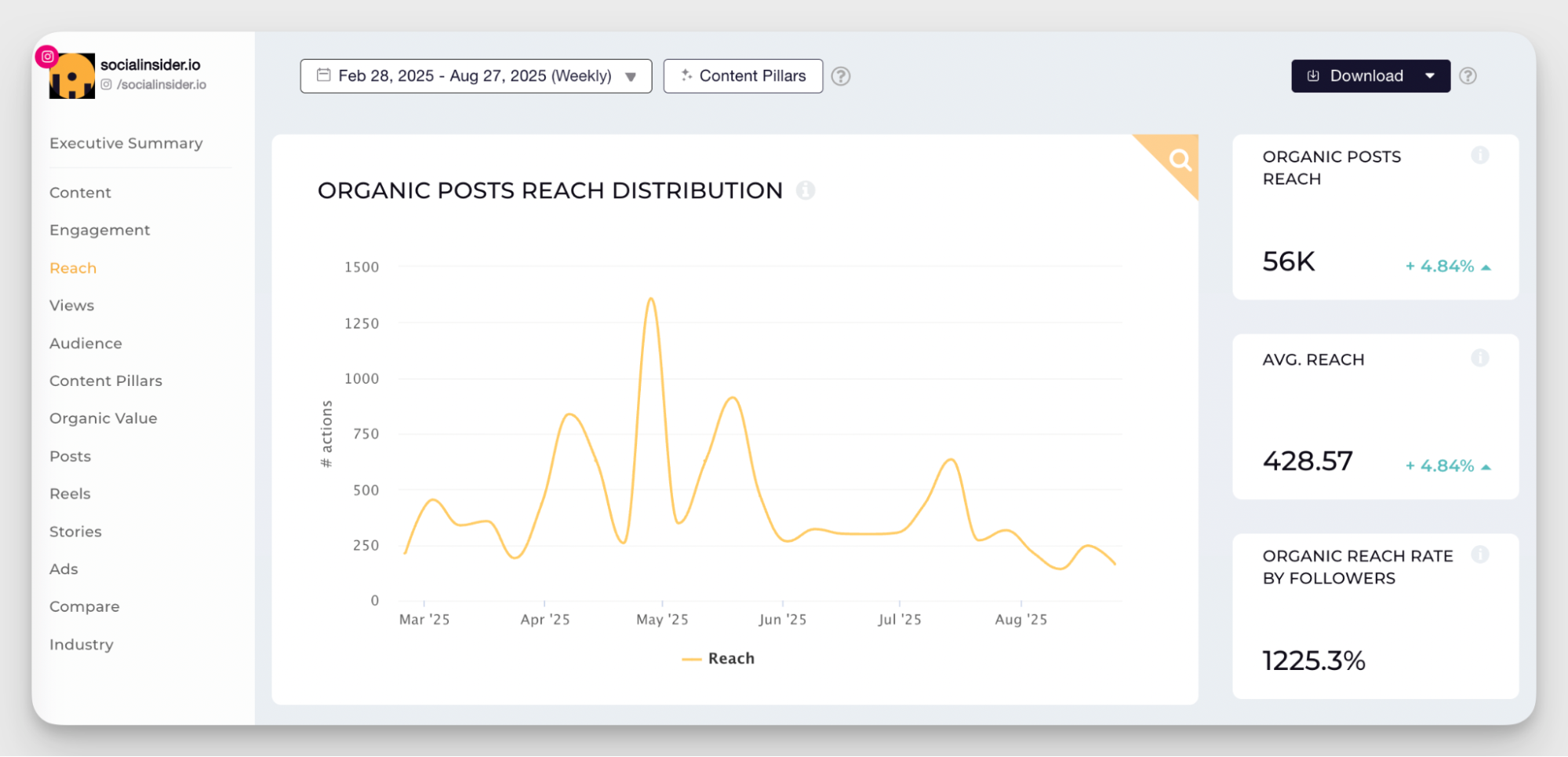
High view counts relative to reach indicate your content successfully stops the scroll. Together, these metrics show whether you're creating content that both spreads and meets audience expectations.
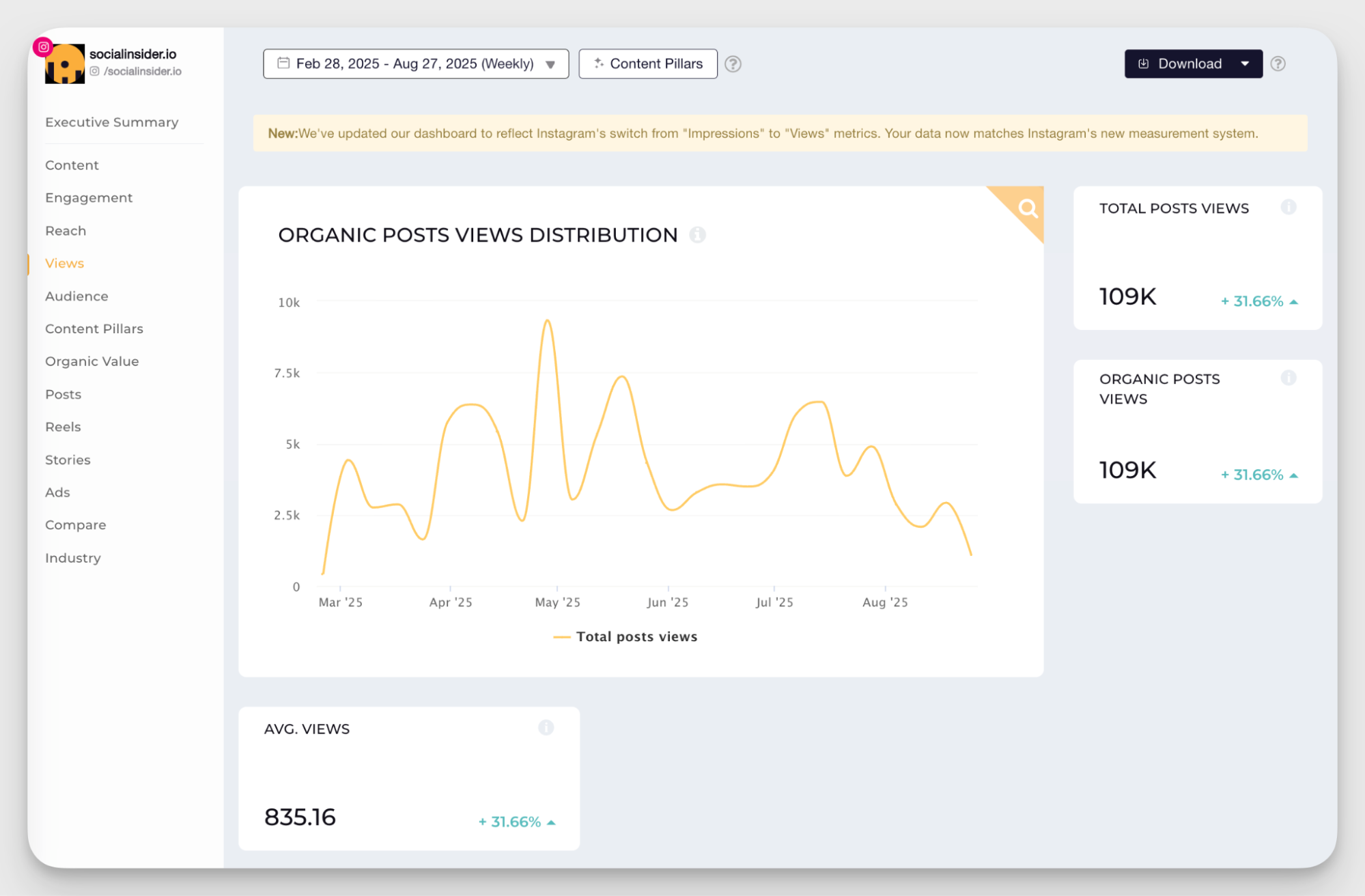
Measure organic vs paid performance
Understanding the balance between organic vs paid social media helps you allocate budgets effectively.
Here's what Alex told me about this:
The whole comparison between organic and paid is crucial. It's essential. What's most important in my eyes is to highlight that both are interdependent. Strong organic content provides valuable insights for creating better ads. Detailed ad evaluations, such as your hooks, the watching times, and the bounce rates, give us better insights into what works well in an organic way. In other words, it's a cycle, where both teams need to work hand in hand.

Now, while not the same, I must tell you abit about Socialinsider's Organic Value. Through this feature, you can assigns dollar values to different KPIs, creating a unified metric for comparing organic and paid efforts.
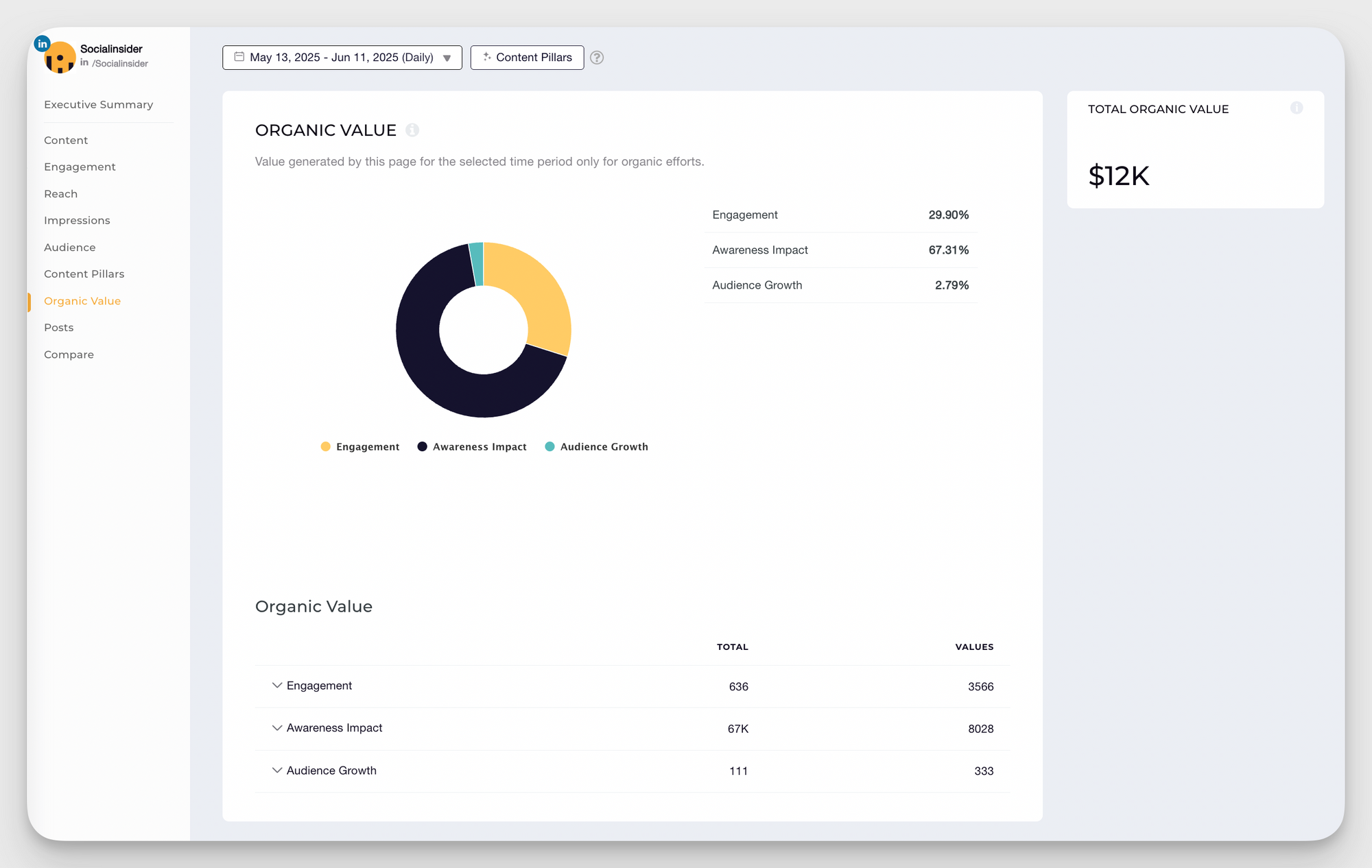
You can customize these values for each platform to reflect your business needs and specific results, as shown below.
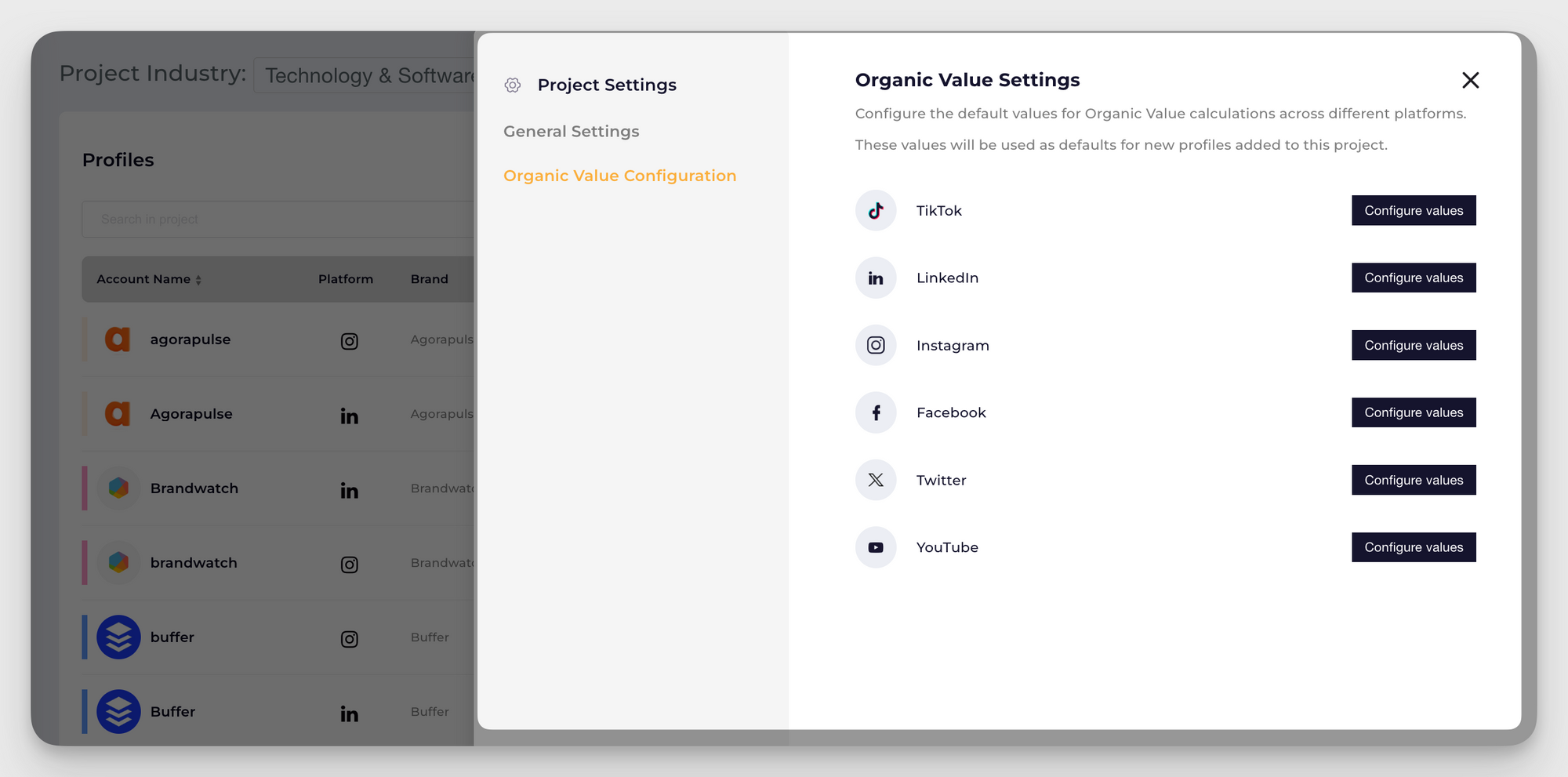
B2B brands might assign higher values to LinkedIn engagement, while B2C brands might weigh Instagram interactions more heavily, for example.
This granular customization per platform and metric type ensures your social media value calculations align with actual business impact. With this, measuring social media ROI will no longer be a confusing, overwhelming mission, trust me.
Benchmark performance across channels
Not all platforms will perform equally for your brand. Cross-channel analysis reveals where your content resonates most and where you're wasting resources.
When comparing organic value across channels or across different channel formats, you might discover that one platform or format delivers exponentially more value despite receiving less resources.
This doesn’t necessarily mean you should abandon underperforming channels. It means you should focus on higher-performing channels, while also analyzing what you can do to improve your presence on the others (if that still makes sense in your social media strategy).
Overall, this analysis aims to help you understand the role of each platform in your overall strategy. You can allocate resources better and make informed decisions about sticking with various platforms or letting go.
Run a multiple-layer data analysis
Surface-level social media metrics only tell part of the story. Take it from me, a powerful social media audit layers different analytical approaches, such as sentiment analysis and AI-powered pattern recognition. These help you go deeper than observing what happened to understand why it happened and what's likely to happen next.
- Sentiment analysis - Engagement volume without sentiment context is dangerous. High engagement from negative reactions requires a different action than positive virality. Track the emotional tone of interactions to understand whether you're building brand love or brand controversy.
- AI usage for strategic insights and forecasting - AI-powered analytics can identify subtle patterns humans miss, like correlations between weather patterns and engagement rates, or the compound effect of using certain word combinations. These insights move you from a reactive to a predictive strategy.
Provide context for the insights by adding competitors' results
Your performance exists in a competitive context. What looks like strong growth might be industry-standard, while seemingly modest metrics might actually represent market-leading performance.
Here's how Alex clarified the purpose of competitive analysis:
We don't want to copy them, but we want to understand trends, like what kind of content pillars work best to provide a competitive advantage and jump on trends very quickly.
General competitive metrics, like the ones below, provide market context. Comparing follower counts shows market share, but comparing engagement rates reveals content effectiveness. A competitor with fewer followers but higher engagement rates has cracked something you haven't.
Notice how Socialinsider goes a step further and actually provides a “Key insights summary” to make your job easier. For me, this simple insertion is particulalry effective since it helps me save a lot of time interpretting the data manually.
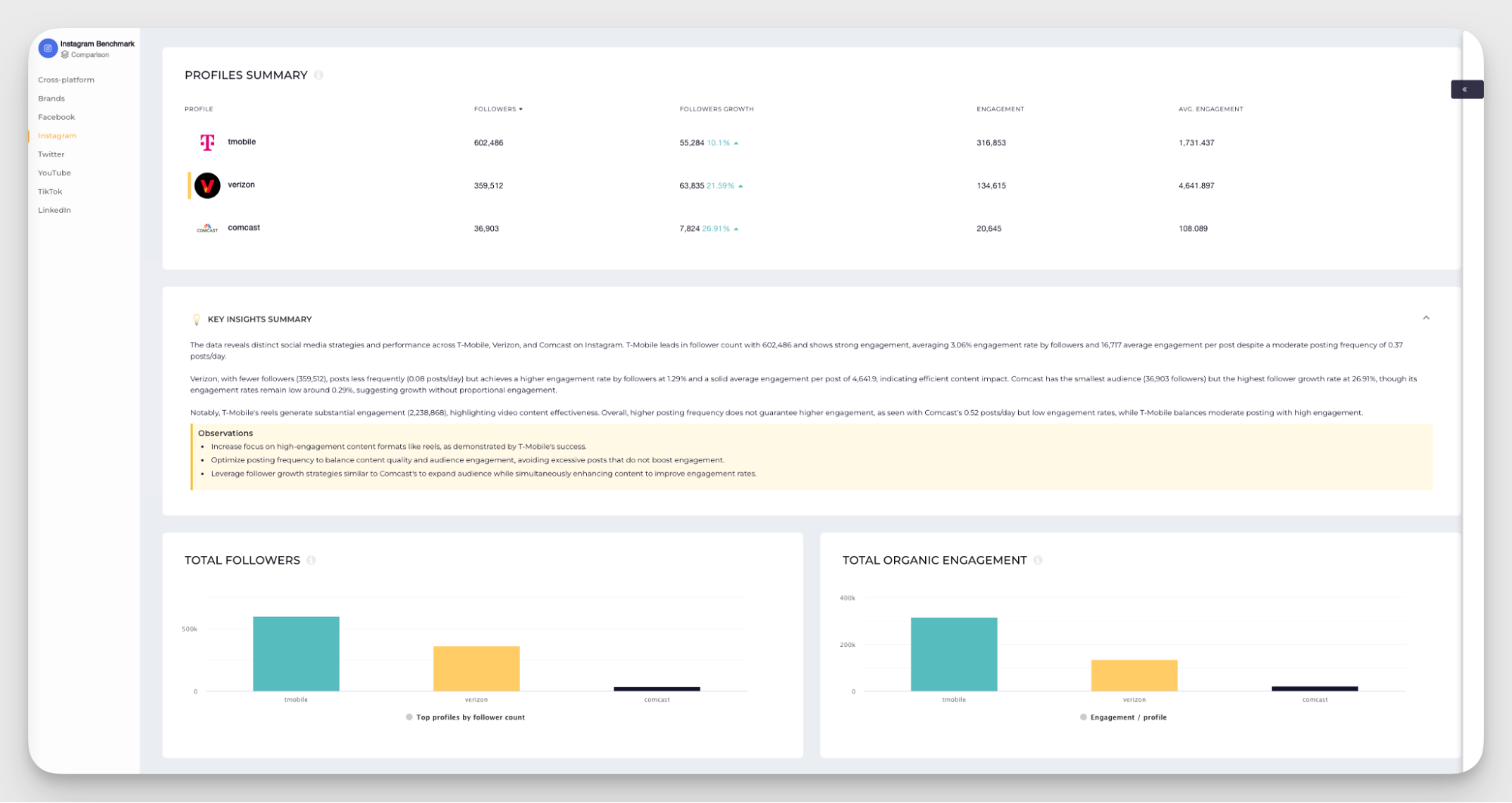
And content pillar comparison goes deeper. When competitors generate higher engagement rates with certain content types despite posting less frequently, they've found a quality-over-quantity sweet spot. These competitive insights inform both what to create and how often to post it.

A social media audit might just seem like an exercise in data collection. In fact, it’s a story-finding quest within that data you already own, that will drive better decisions. With the right social media audit tools and a systematic approach, you can transform overwhelming metrics into clear action items that improve your social media performance month over month.
Next, let me guide you through a couple of the best tools on the market right now.
Social media audit tools
A social media audit can be a tedious spreadsheet exercise — I’ve been there, and it’s not fun or efficient.
Or it can be an actually enjoyable process that quickly returns valuable insights.
If you prefer the latter option, here are some tools that can make it happen.
Socialinsider: best for social media analytics
When you're conducting a social media audit, the difference between spending a full day collecting data and getting comprehensive insights in under two hours comes down to your analytics platform.
Socialinsider brings together what typically requires multiple tools into one unified dashboard.
The platform's multi-channel consolidation means you're analyzing TikTok, Instagram, LinkedIn, Facebook, Twitter, and YouTube performance side by side. Yes, that means no more jumping between native analytics or struggling to compare apples to oranges.
This cross-platform view, which you’ve seen examples of above, reveals patterns you'd never spot looking at channels in isolation.
What sets Socialinsider apart is how it handles competitive context. Your metrics don't exist in a vacuum. That 3% engagement rate might be industry-leading or seriously underperforming, depending on your sector. The platform's competitive benchmarking capabilities let you compare your performance against any public account, giving you valuable context. You're not just tracking your growth, you're understanding your market position.
What I love most is that the AI-powered content clustering automatically organizes your posts into thematic pillars, revealing which topics consistently drive engagement without manual tagging. This feature alone saves hours of categorization work while uncovering content patterns you might have missed.
Combined with the ability to identify top-performing posts and optimal posting patterns (with historical data readily available), you're getting prescriptive guidance, not just descriptive metrics.
The executive summary feature condenses complex data into digestible insights, which is perfect for stakeholders who need the story, not the spreadsheet. You can schedule reports, share dashboards, and ensure everyone's working from the same data source.
The best part is that you don't need a data science degree to understand the social media analytics dashboards. The intuitive interface guides you from high-level performance down to post-level insights.
If you’d like to try all this for yourself, take advantage of Socialinsider’s 14-day free trial.
On an ending note, Alex walked me through his audit process, highlighting how Socialinsider fits into his agency's needs:
Our audit process begins by mapping out all of the active accounts along with our key competitors. So we use Socialinsider to connect multiple profiles and consolidate all performance data into one single centralized dashboard and during that content phase your platform enabled us to identify top performing formats, post types, cross-channel trends, which again provides us valuable insights into data-driven insights like what resonates effectively with each industry.
Meta Ads Library and TikTok Creative Center: recommended for ads analysis
Meta Ads Library is a free, publicly accessible database that shows you every active ad from any advertiser. You can filter by country, media type, and status to see exactly what competitors are testing in your market.
While it won't reveal targeting specifics or performance metrics for commercial ads, the creative insights alone are valuable. You'll see what messaging angles competitors are pushing, which formats they're investing in, and how their creative strategy evolves over time.
The main limitation is the lack of performance data for non-political ads — you're seeing what's running, not necessarily what's working. Still, when an ad runs for months, that longevity usually signals success.
TikTok Creative Center provides trend-driven creative intelligence. The Top Ads section showcases high-performing creatives with actual view counts and engagement metrics, giving you rare visibility into what's actually working on the platform.
The platform's Creative Patterns feature identifies winning elements across successful ads, whether it's specific visual styles, music choices, or narrative structures.
The trade-off is platform specificity. These insights only apply to TikTok, but given TikTok's influence on creative trends across all platforms, what works here often translates elsewhere with adaptation.
Awario: recommended for social listening
Awario is a social listening tool that monitors mentions across social media, blogs, news sites, and forums.
The platform lets you craft precise searches that filter out noise, essential when your brand name overlaps with common words. Sentiment analysis, while not perfect with sarcasm or slang, gives you a quick temperature check on brand perception trends.
For audit purposes, Awario provides the context around your social media performance. A spike in negative sentiment is likely the reason why engagement dropped. A surge in mentions indicates which content has broken through to earned media. The geographic and language filters ensure you're monitoring the right conversations in the right markets.
Social media audit example
Here’s a real-world social media audit I ran, using @tldv.io's Instagram presence to put all these ideas into practice. For brevity reasons, I’m focusing on one platform here, but you can replicate the method for other platforms.
This B2B SaaS company offers AI-powered meeting intelligence, and its Instagram strategy provides valuable lessons about balancing entertainment with business objectives.
Remember the steps I outlined in the first part of the article? Let's walk through them.
Branding consistency analysis
- Profile image: Their logo is clear and instantly recognizable, maintaining consistency across platforms.
- Website link: The bio includes their domain (tldv.io), making the path to conversion straightforward.
- Bio SEO optimization: While they mention "Meeting Intelligence for #sales #product #uxresearch #customerservice", this reads more like keyword stuffing than compelling copy. A stronger approach would combine keywords with value, something like "AI meeting recorder that actually gets you | Save 10 hrs/week on note-taking."
Content analysis
- Best-performing content formats: It’s clear: Reels dominate their strategy. A Reel featuring a candid conversation between a product owner and a developer garnered over 3.4 million views and 90K likes, which is great reach and engagement for a B2B tool. While not all Reels perform as well, they consistently receive a few thousand likes.
- Meanwhile, static posts are nearly absent from their feed, and carousels (typically strong for B2B education) are nowhere to be found.
Key finding: Short, relatable Reels mixing humor with workplace themes are the winning format.
Most engaging content pillars
Three distinct content pillars are present:
- Relatable work culture humor (tech and sales skits) drives the highest engagement
- Productivity and AI insights provide educational value that resonates with their ideal customer profile
- Product-focused posts (demo Reels) generate lower engagement than humor but build awareness
Top-performing posts' common traits
- Hook: Short, witty openers that immediately relate to tech/startup life
- Format: Reels leveraging trending audio (algorithm boost plus cultural relevance)
- Tone: Playful and meme-driven, speaking the language of their audience
- CTA: Often implicit, entertainment first, product second (or never)
Audience demographics data analysis
Without access to their Instagram analytics, I can infer from engagement patterns:
- Likely millennial-heavy (25-34), given the meme literacy and startup culture references.
- Global English-speaking audience (universal startup humor, no regional specificity).
- ICP alignment: Strong match as their content attracts tech professionals who could become users
Performance data analysis
KPIs against objectives comparison
- Followers: 144K represents a strong foundation for a B2B SaaS tool
- Engagement rate: Exceptional on humor Reels (some exceeding 90K likes), but significantly lower on product-focused content
Organic vs paid performance
No visible paid ads appear in Meta's Ad Library at the time of this audit, suggesting their growth is primarily organic. The viral nature of their Reels acts as their primary growth engine, which is pretty impressive.
Benchmarks across channels
Since this is an Instagram-only audit, benchmarking will compare formats within the channel:
- Reels vastly outperform static posts (which are almost non-existent)
- Stories appear underutilized (based on highlight activity)
- Missing opportunity: Educational carousels that could bridge entertainment and conversion.
Multi-layered data analysis
- Sentiment analysis: Overwhelmingly positive. Comments sections are filled with laughing emojis and relatable responses, with minimal negative interactions visible.
- Predictive insights: The humor-first strategy will likely continue driving reach, but without educational content to establish authority, they risk being seen as entertainment rather than a serious business tool.
Competitive context
Comparing against similar B2B SaaS brands on Instagram (Notion, Loom, Miro):
- Competitors' approach: Brands like Loom and Notion balance humor with educational carousels and aesthetic product showcases. They've built visual brand identities beyond just entertainment.
- tl;dv's differentiation: They've gone all-in on humor-driven Reels, creating higher virality but less brand authority.
- Strategic opportunity: tl;dv could maintain their humor advantage while introducing weekly educational carousels (such as "5 meeting mistakes killing your productivity"). This would:
- Position them as industry thought leaders, not just entertainers
- Create content that directly connects to their product value
- Provide sales teams with shareable educational assets
- Balance top-of-funnel awareness with mid-funnel education
Conclusion:
tl;dv has cracked the Instagram virality code for B2B, but they're leaving opportunities on the table by not connecting entertainment to education. Recommended action: blend the proven humor formula with strategic educational content that transforms viewers into users.
Final thoughts
In short, running a social media audit transforms guesswork into a strategic approach. Whether you discover untapped opportunities or confirm what's working, the clarity alone justifies the effort. The key is to start as soon as possible and use the right tools to make the process easier and more valuable.
Alex Khan provides encouraging, practical advice for getting started: "Don't overthink it. You can be sure that your first 10, 20, 30, 40 posts will not be as good as you want them to be. The problem is you don't know what is good. You need to post them first and then see what worked and what didn’t."
If you're ready to conduct your own comprehensive audit, try Socialinsider for free and get the insights that turn your social media presence into a measurable growth engine.
Analyze your competitors in seconds
Track & analyze your competitors and get top social media metrics and more!
You might also like
Improve your social media strategy with Socialinsider!
Use in-depth data to measure your social accounts’ performance, analyze competitors, and gain insights to improve your strategy.



